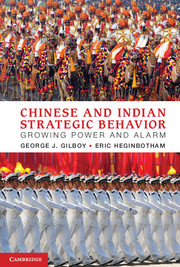Book contents
- Frontmatter
- Contents
- Figures
- Tables
- Acknowledgments
- Preface
- Abbreviations
- Map
- 1 Introduction
- 2 Strategic Culture
- 3 Foreign Policy, Use of Force, and Border Settlements
- 4 Military Modernization
- 5 Military Doctrine
- 6 Military Force Modernization and Power Projection
- 7 Economic Strategic Behavior
- 8 India, China, and Democratic Peace Theory
- 9 Meeting the Dual Challenge
- Appendix Defense Spending, Selected Additional Data
- Bibliography
- Index
- References
8 - India, China, and Democratic Peace Theory
Published online by Cambridge University Press: 05 June 2012
- Frontmatter
- Contents
- Figures
- Tables
- Acknowledgments
- Preface
- Abbreviations
- Map
- 1 Introduction
- 2 Strategic Culture
- 3 Foreign Policy, Use of Force, and Border Settlements
- 4 Military Modernization
- 5 Military Doctrine
- 6 Military Force Modernization and Power Projection
- 7 Economic Strategic Behavior
- 8 India, China, and Democratic Peace Theory
- 9 Meeting the Dual Challenge
- Appendix Defense Spending, Selected Additional Data
- Bibliography
- Index
- References
Summary
Side-by-side comparisons in the preceding chapters have revealed broad similarities in Indian and Chinese international strategic behavior. Despite some important specific differences that come into focus through structured comparison, neither state can be described as generally more prone than the other to foreign policy realpolitik, the use of force, and a preference for offensive military doctrine. Neither is more intent on modernizing its military forces, pursuing trade protectionism, or working with rogue regimes to secure energy interests. But what of the future? The two states have starkly different domestic regimes – India has a vibrant democracy, China has an adaptive but enduring authoritarian state. Is the difference in regime type a useful predictor of future international strategic behavior? Can projections based on regime type help U.S. leaders determine how the two powers will behave relative to U.S. interests?
In this chapter, we explore two claims made by scholars and policy makers about the relationship between regime type and a state’s international security behavior. The first claim is that democracies are more prone to peace than nondemocracies. The core of this argument is that democracies do not fight wars with one another, although in public and policy debates, the argument is frequently broadened to assert that democracies are more peaceful in general. The second claim is that shared political values (specifically democracy and rule of law) tend to cause the security interests of democratic states to converge. These ideas have broad appeal among both elites and the general public in the United States, and are frequently cited in debates about U.S. policy toward both China and India.
- Type
- Chapter
- Information
- Chinese and Indian Strategic BehaviorGrowing Power and Alarm, pp. 251 - 263Publisher: Cambridge University PressPrint publication year: 2012



